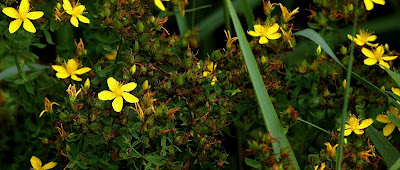In any marshy wet area, you are bound to find a lot of Dragonflies and Damselflies. The Common Whitetail Libellula lydia, an abundant species, were literally on every rock surrounding the parking area.
Another common species is the Eastern Pondhawk, Erythemis simplicicollis. I see it everywhere, but that rich green color is irresistible. I shoot it whenever I find it. This is a female, the male is a more drab blue in color.
Another bright green species is the Eastern Forktail, Ischnura verticalis. This is a Damselfly of course, not a Dragonfly. This time we are looking at a male.
Here is an Eastern Forktail female. The sky blue color and two-toned eyes are what to look for. As I've mentioned before, when working with damsels and dragons, males and females will appear SO different as to think you have two different species.
I came across this for the first time last summer. Here it is again. The close up shots are to show the identification. This is the Double-striped Bluet, Enallagma basidens. I remember the name by looking at the thorax. The black stripes are split by a thin blue line, both on top and on the side.
You could look at the abdomen for a clue. Each segment is both black and blue, with the 7th segment behind the wings almost all black on top. Segment 8 & 9 are all blue. Each abdominal segment has black that looks like it is 'dripping' down the side. Immediately behind that is a small black ring. This is also how some people remember the name Double-striped.
The three branched mass of leaves look like mossy goo when pulled from the water. Clicking on the photo will show lots of oval shaped holes among the leaves. This is where the bladders are located.
Every good wetland will have Carex Sedges in them. I continue to collect and photograph these in hopes of one day working on them again. 20 years ago I learned dozens of them in a couple weeks time. But you know what they say, "use it or lose it." I haven't worked with them in so long I'll have to start from scratch and relearn them all.
Disturbed sites are a good place for Black Locust trees to get a foothold. If you ever notice the ends of the twigs swollen like this, it's from a Tortricid moth known as Ecdytolopha insiticiana, the Locust Twig Borer.
Wild Carrot Daucus carota, or Queen Anne's Lace is another exotic found in open areas. The roots are quite edible. The flowers do provide a nectar source for many small insects.
One of those is the Cuckoo Wasp. This may be Holopyga ventralis, but honestly, all the Cuckoo wasps look similar. With a face full of pollen like that, I was just waiting for it to sneeze. Cuckoo wasps are parasitic on other insects and not known to sting people. I have seen their stingers, so I'm not interested in testing myself to find out for sure. Many roll into a ball for defense.
Spotted St. John'swort Hypericum maculatum, is one of the more common species of St. John'swort. Sometimes the edges of the flower petals are dotted, but you can be sure by looking under the leaves for black spots which gives it the name.
Down in the mudflats was this delicate looking species. This is the Dwarf St. John'swort, Hypericum mutilum. This is one of the smaller species, growing about a foot high. Look for it in marshes and swamps. The flowers are so small that the green sepals are as long as the petals. Other tiny St. John'swort species have very narrow leaves, not broad like these.
Mimulus ringens, the Square-stemmed Monkey-flower is a member of the Scrophulariaceae. Just because it has a square stem doesn't automatically mean it's a Mint. Some say the flower looks like a monkey face. Maybe a Baboon with it's mouth open? I don't see it, so much for common names. This is another common species of wet sites.
Not nearly as showy as its relatives the Arrowheads, the Water Plantain is still an important wetland plant that waterfowl feed on. The three white petals are extremely small on this species. They barely stick out past the sepals. That would make this Alisma subcordatum. A similar species, A. triviale has flowers about twice as long as the sepals.
Buttonbush, Cephalanthus occidentalis, is a woody shrub of wetlands now coming into peak bloom. The most abundant insects on these flower heads will be Bumblebees.




















No comments:
Post a Comment